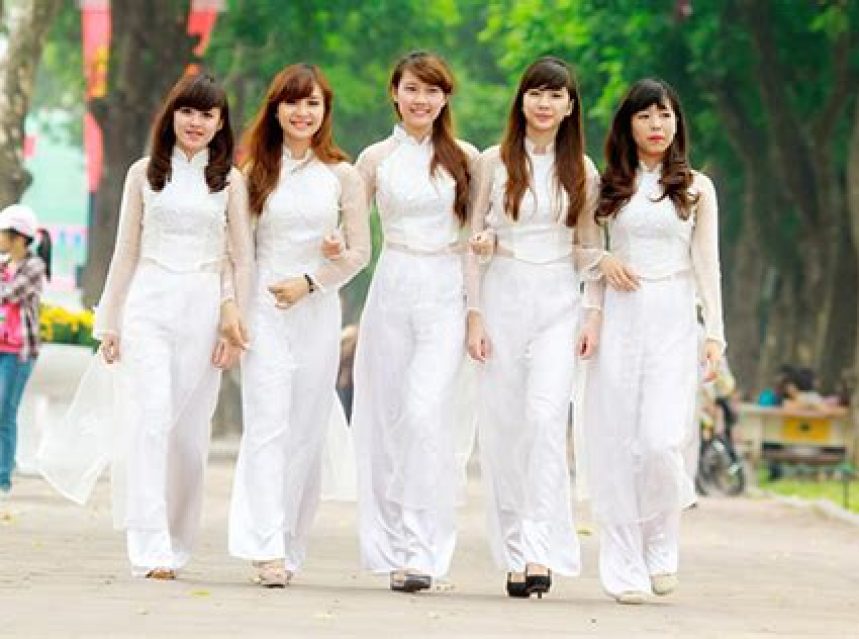Vietnam School Uniform

Introduction:
In Vietnam, school uniforms have long been an integral part of the education system, reflecting the country’s deep-rooted cultural traditions. The evolution of these uniforms over time has showcased the changing societal values and educational ideals. Embedded with a profound purpose and significance, school uniforms in Vietnam have not been without controversy. However, amidst the debates surrounding their relevance, efforts have been made to modernize these uniforms, striking a balance between tradition and contemporary style. Let us delve into the fascinating journey of school uniforms in Vietnam, exploring their history, purpose, significance, controversies, and the ongoing push for modernization.
Traditional school uniforms in Vietnam
Traditional school uniforms in Vietnam hold a significant cultural value and have been an integral part of the country’s education system for centuries. These uniforms not only symbolize students’ affiliation with their respective schools but also reflect the Vietnamese society’s emphasis on discipline and uniformity. The evolution of school uniforms in Vietnam has seen several changes over time, but the traditional elements have remained consistent. Let’s explore the purpose and significance of these uniforms, as well as the controversies surrounding them and the efforts made to modernize them.
One of the key purposes of traditional school uniforms in Vietnam is to foster a sense of pride, unity, and equality among students. These uniforms act as a visual representation of a student’s commitment to their education and the values upheld by the educational institution. Wearing the same uniform eliminates any distinctions based on economic or social backgrounds, creating a sense of equality and camaraderie among the students. Moreover, these uniforms promote discipline and orderliness among the students, teaching them the importance of adhering to rules and regulations from a young age.
Despite the significant cultural and social significance of traditional school uniforms in Vietnam, there have been ongoing controversies surrounding their implementation. Critics argue that these uniforms can stifle individuality and self-expression among students. They believe that uniforms restrict students from showcasing their personal style and creativity, which are important aspects of their personality development. Additionally, the strict rules regarding the length of skirts or trousers and specific colors can sometimes lead to discomfort and hinder students’ ability to focus on their studies.
| Pros | Cons |
|---|---|
| 1. Promotes unity and equality. | 1. Limits individuality and self-expression. |
| 2. Instills discipline and orderliness. | 2. Can lead to discomfort in certain cases. |
| 3. Represents commitment to education. | 3. Requires additional expenses for the families. |
Efforts have been made to modernize school uniforms in Vietnam while preserving the core elements of tradition and culture. In recent years, there has been a shift towards more comfortable and functional uniforms that cater to the needs of the students. Some schools have introduced variations of the traditional uniforms, allowing students to choose from different styles and colors within certain guidelines. This approach aims to strike a balance between preserving the cultural significance of uniforms and providing students with some degree of choice and flexibility. These efforts reflect the continuous evolution and adaptability of Vietnamese educational institutions.
In conclusion, traditional school uniforms in Vietnam play a vital role in shaping the educational experience of students. They foster a sense of unity, equality, and discipline, while also reflecting the rich cultural heritage of the country. However, the controversies surrounding uniforms highlight the need for ongoing discussions and potential modifications to address concerns regarding individuality and discomfort. The efforts to modernize school uniforms demonstrate a commitment to adapt to changing times while staying true to the core values of tradition and education in Vietnam.
The evolution of school uniforms in Vietnam
School uniforms in Vietnam have evolved significantly over the years. The traditional school uniforms in Vietnam have undergone several changes in terms of design, colors, and styles. These changes were influenced by various factors such as socio-cultural changes, fashion trends, and the desire to create a sense of identity and discipline among students.
Initially, the traditional school uniforms in Vietnam were simple and conservative. They consisted of a white shirt, usually with long sleeves, and dark-colored trousers or skirts. The focus was on modesty and uniformity, with little room for individuality or self-expression.
However, as Vietnam underwent modernization and social changes, the school uniforms began to reflect these transformations. The evolution of school uniforms in Vietnam can be traced back to the late 20th century when the country opened up to globalization and embraced Western influences.
Purpose and significance of school uniforms in Vietnam
School uniforms have always held a significant role in the education system of Vietnam. The purpose of school uniforms in Vietnam goes beyond merely distinguishing students based on their school and grade level; it serves as a symbol of identity and unity within the educational community. The significance of school uniforms in Vietnam can be seen in various aspects of students’ lives, including their behavior, discipline, and academic performance.
One of the primary purposes of school uniforms in Vietnam is to instill a sense of discipline and order among students. By wearing uniforms, students are taught to adhere to a set of rules and regulations that govern their appearance and behavior. This fosters a disciplined environment in schools and helps students understand the importance of following guidelines and codes of conduct. It also creates a sense of equality among students, as everyone is dressed the same, regardless of their socioeconomic backgrounds.
In addition to discipline, school uniforms in Vietnam hold a significant cultural and social significance. Uniforms often represent the values and traditions of the Vietnamese culture, such as modesty and respect. They also serve as a symbol of unity and belonging within the school community. When students wear their uniforms, they feel connected to their peers and develop a sense of identity as part of a larger group. This can have a positive impact on students’ self-esteem and overall well-being.
- The purpose of school uniforms in Vietnam is to instill discipline and order among students.
- Uniforms represent the cultural and social values of Vietnam.
- Wearing uniforms creates a sense of unity and belonging within the school community.
| Purpose | Significance |
|---|---|
| Instill discipline and order | Represent cultural and social values |
| Create a sense of unity and belonging |
Controversies surrounding school uniforms in Vietnam
School uniforms have long been a topic of controversy in Vietnam. While some argue that they promote unity and equality among students, others believe that they suppress individuality and creativity. The debate over school uniforms in Vietnam is not limited to students and parents, but also involves educators, policymakers, and the wider society. In this blog post, we will explore the different controversies surrounding school uniforms in Vietnam.
One of the main controversies surrounding school uniforms in Vietnam is the issue of cost. Many families in Vietnam struggle to afford school uniforms, especially those living in rural areas or low-income households. School uniforms can be expensive, and families may have to sacrifice other essential expenses to purchase them. This creates a significant financial burden for parents, leading to a debate on whether school uniforms should be mandatory or if there should be provisions to support families who cannot afford them.
Another controversy surrounding school uniforms in Vietnam is the restriction of individuality. Critics argue that school uniforms suppress students’ creativity and self-expression. By enforcing a strict dress code, students are not able to showcase their personal style or cultural identity. This can have a negative impact on their self-confidence and may hinder their ability to explore their own unique talents and interests.
Furthermore, the enforcement of school uniforms has been criticized for its effectiveness in promoting discipline and reducing social inequality. Some argue that focusing on uniforms as a disciplinary measure overlooks addressing the underlying issues causing behavioral problems among students. Additionally, the requirement of school uniforms may reinforce a sense of hierarchy and social status among students based on the quality or style of their uniforms, rather than fostering a sense of equality.
- High costs: Many families struggle to afford school uniforms, creating a financial burden.
- Suppression of individuality: School uniforms restrict students’ creativity and self-expression.
- Effectiveness and social inequality: The enforcement of school uniforms may not effectively address disciplinary issues and can reinforce social hierarchies.
| Pros | Cons |
|---|---|
| Promote unity: School uniforms can promote a sense of unity among students, fostering a sense of belonging and equality. | Costly: School uniforms can be expensive, putting a financial burden on families. |
| Enhance safety and security: School uniforms help distinguish students from outsiders, ensuring a safer school environment. | Suppression of individuality: School uniforms may restrict students’ ability to express themselves and explore their personal style. |
| Simplify dress code: School uniforms provide a clear and standardized dress code, reducing distractions and conflicts related to clothing choices. | Potential to reinforce social inequality: School uniforms may create a sense of hierarchy based on the quality or style of uniforms, leading to social divisions. |
While controversies surrounding school uniforms in Vietnam persist, it is important to approach the topic with an open mind and consider the diverse perspectives involved. Ultimately, the aim should be to strike a balance between promoting unity and equality while respecting students’ individuality and financial circumstances.
Efforts to modernize school uniforms in Vietnam
Efforts to Modernize School Uniforms in Vietnam
In recent years, there have been significant efforts to modernize school uniforms in Vietnam. This ongoing process involves updating the design, materials, and overall appearance of traditional school uniforms to better reflect the changing times and meet the needs and preferences of students.
One of the main objectives of modernizing school uniforms in Vietnam is to promote equality and inclusivity among students. Schools are increasingly recognizing the importance of allowing students to express their individuality while maintaining a sense of unity and belonging. To achieve this, many schools are now offering a variety of uniform options, such as different styles, colors, and accessories, for students to choose from. This not only allows students to showcase their personal style and preferences, but also helps to reduce the stigma associated with uniforms and foster a more positive and inclusive school environment.
In addition to promoting individuality, modernized school uniforms in Vietnam also prioritize comfort and practicality. Traditional uniforms often consisted of heavy and restrictive materials, making it difficult for students to move freely and comfortably throughout the day. However, with the growing emphasis on physical activity and well-being, schools have started to incorporate lighter and more breathable fabrics into their uniform designs. This shift not only enhances the overall comfort of students but also encourages them to engage in various physical activities without feeling constrained by their attire.
Furthermore, modernizing school uniforms in Vietnam also involves incorporating sustainable and eco-friendly practices. Many schools are now opting for organic and environmentally friendly materials when designing uniforms. This not only promotes sustainability but also educates students about the importance of caring for the environment. Additionally, by implementing durable and long-lasting materials, schools are reducing the need for frequent replacements, leading to less waste and ultimately contributing to a greener future.
- To summarize, efforts to modernize school uniforms in Vietnam are aimed at promoting equality, individuality, comfort, and sustainability. By offering a variety of uniform options, schools are ensuring that students can express their personal style while still maintaining a sense of unity. The use of lightweight and breathable fabrics enhances the overall comfort and allows students to engage in physical activities with ease. Lastly, schools are adopting sustainable practices by utilizing organic and eco-friendly materials, reducing waste, and promoting a greener future.
Frequently Asked Questions
Question 1: What is the significance of school uniforms in Vietnam?
School uniforms in Vietnam serve as a symbol of unity and discipline among students. They promote a sense of equality and create a more focused learning environment.
Question 2: How have school uniforms in Vietnam evolved over time?
Over the years, school uniforms in Vietnam have undergone changes in style and design to reflect modern societal values. The traditional ao dai has been modified to be more practical and comfortable for students.
Question 3: What is the purpose of school uniforms in Vietnam?
The purpose of school uniforms in Vietnam is to eliminate social and economic differences among students, fostering a sense of belonging and reducing peer pressure related to fashion.
Question 4: Are there any controversies surrounding school uniforms in Vietnam?
Yes, there have been debates about the rigid nature of school uniforms and the limitations they impose on individual expression. Some argue for more flexibility in clothing choices to allow students to showcase their personal identities.
Question 5: How are efforts being made to modernize school uniforms in Vietnam?
Efforts to modernize school uniforms in Vietnam include incorporating new materials, incorporating functional elements such as pockets, and experimenting with different colors and designs, while still maintaining the core identity.
Question 6: Do school uniforms in Vietnam vary based on the educational level?
Yes, school uniforms in Vietnam may differ slightly based on the educational level. For example, primary school students might wear simpler designs compared to high school students, who may have more formal and distinguishable uniforms.
Question 7: Are there any specific regulations regarding school uniforms in Vietnam?
Yes, there are regulations set by the Ministry of Education and Training in Vietnam that outline the basic requirements for school uniforms, including color, design, and logo placement. Schools are expected to adhere to these guidelines.



